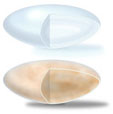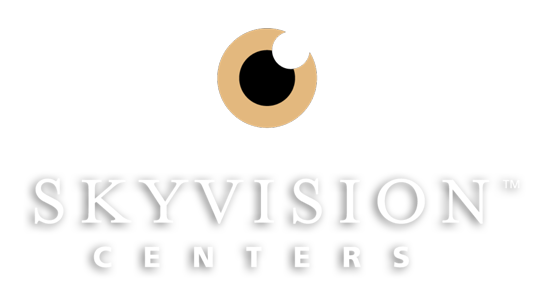SkyVision Center is the premium practice for
advanced cataract care in northeast Ohio!

Whether you choose a basic high-tech implant or one of the advanced high-tech implants, your cataract surgery will be performed by one of the premier cataract surgeons in the United States!
Did you know that our very own Dr. Darrell E. White was the first cataract surgeon to use an advanced technology focusing implant in the state of Ohio?
What is a Cataract? How do I know if I have one?

Cataract development is a normal process of aging. Eventually, nearly everyone will develop a cataract. Cataracts can also develop from injuries to the eye, certain medications (such as steroids), some diseases, and some genetic conditions. Once a cataract starts to form, no one can predict how quickly it will develop or grow.
There are no medicines, eye drops, exercises, or glasses that will cause cataracts to disappear or prevent them from eventually forming. Surgery is the only way to remove a cataract.
Cataract Symptoms
Your symptoms generally determine when cataract surgery is necessary. Someone with a cataract may experience some or all of the following:

- Difficulty reading
- Difficulty driving, especially at night
- Light sensitivity or glare
- Difficulty seeing in dim light
- Painless blurry or filmy vision
- Yellowing or fading of colors
When you are no longer able to do the things you like to do, cataract surgery should be considered. Sometimes, your doctor may need to suggest cataract surgery to help treat other eye problems such as glaucoma or diabetic eye disease.
The next step
If you think you may have a cataract and wish to be evaluated, you may set up an appointment by clicking on this link or by calling 440-892-3931.
Cataract surgery involves the extraction of the cataract and implantation of an intraocular lens. Due to the advancement in cataract care, patients now may have several options for the type of intraocular lens implant they may wish to have. Over one million people in the United States have cataract surgery each year. 95% to 98% of these people have dramatically improved vision after surgery.
There are three types of intraocular lens implants for patients. After completing a thorough cataract evaluation, your Skyvision doctor will make a recommendation as to the best type of implants for achieving the best quality of vision based on your medical history and preferences.
The three categories of implants are:
- Basic monofocal implants
- Toric implants – correction for those with astigmatism
- Advanced technology implants – either multifocal or EDOF (expanded depth of focusing)
The first category is an insurance based lens while the other two lens types involve additional popular technology and are considered elective options with regards to insurance. Regardless of the type of lens implant, the procedure is the same and the cataract surgery including the surgeon’s fee, facility fee and anesthesia are all covered expenses under your medical insurance.
Monofocal Lens Implant – Your Basic Implant
This is the most basic lens exchange. We remove the lens and replace it with a new implant. We can choose the power of the implant so that we can better meet your vision goals. The lens does not focus on its own, so a patient may need to wear glasses to fine tune the vision and to focus from distance to near.
Once we know your refractive measurements, we work with you to develop the best strategy for meeting your goals. Typical choices include:
Distance Vision: in which a patient desires the best possible distance vision without glasses, but does not mind wearing them for near. This is similar to typical LASIK.
Intermediate Vision: in which a patient desires the best possible vision at intermediate range. This is most helpful for people who spend a lot of time on the computer. These patients may still need glasses for distance, near, or occasionally both.
Near Vision: in which patient desires the best possible near vision without glasses, but does not mind wearing them for distance.
Blended Vision (Distance and Intermediate): in which we adjust the focus of each eye so that one eye is focused for distance, and one for intermediate vision. (Note: this is not monovision, when one eye is focused for distance and one for near. We find this difficult for most patients to adjust to, but most adjust quite well to blended vision)
Toric Lens Implant – Astigmatic Correction For Excellent Distance Vision
When you have astigmatism the cornea, the window to your eye, is shaped more like a football than a basketball; it is longer in one direction than the other. Unless something is done to correct your astigmatism you will need to wear glasses or contact lenses for ALL of your vision needs. The Toric Implant is an Advanced Technology lens that corrects for your astigmatism. Most people who choose this implant are free from the need to wear glasses for far-away vision tasks like driving or watching TV. This category of lens implants had proven to be very successful.
Multifocal and EDOF Advanced Technology Lens Implants
The multifocal and EDOF (Extended Depth of Focusing) lenses are a unique technological innovation that can provide you with quality vision throughout the entire visual spectrum – near through distance – with increased independence from reading glasses or bifocals!
How do the advanced technology lens implants work?
As we perform daily activities such as reading, watching television or working at the computer, our eyes are constantly focusing on objects at varying distances – up close, far away and everything in-between. The ability to quickly change focus throughout this range of vision is called accommodation. Unfortunately, this ability diminishes as we grow older, causing us to become dependent on bifocals or reading glasses.
For most patients, these advanced technology lenses deliver excellent near and distance vision, and good intermediate vision without reading glasses or bifocals. In fact, with this increase in vision quality patients would be able to pass the visual acuity portion of the driver’s license exam in most states.
The advanced technology lenses deliver quality vision for various lighting situations.
“Historically multifocal lens implants have been associated with some side effects including glare at night time. The newest of these lenses have much less of this in comparison, and the symptoms that do occur tend to resolve over time in the overwhelming majority of patients”, says Dr. Darrell White.

